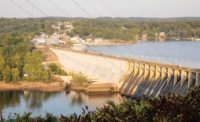FRUITGROWERS DAM OUTLET GATE IMPROVEMENTS
Orchard City, Colo.
BEST PROJECT
Submitted by: Kissner General Contractors
OWNER Orchard City Irrigation District
LEAD DESIGN FIRM Bureau of Reclamation
GENERAL CONTRACTOR Kissner General Contractors
ELECTRICAL SUBCONTRACTOR White Star Electric
This project removed and replaced reservoir regulating and emergency valves with two 24-in. triple offset butterfly valves and motorized actuators at a Colorado dam. During dewatering, the contractor removed the existing valves and pipe spool, along with all components within the 50-ft deep shaft. But before dewatering operations could be suspended, crews had to install the upstream emergency valve. Next the existing pipe was sandblasted and painted, then the new shaft and actuator components were installed.
Although the client expected water flows of 1-5 cu ft per second (CFS) during the unwatering schedule, the team had to contend with flows between 10-18 CFS. Unexpected water inundations caused silt, debris and fish to build up around the sumps and intake structure screen. To manage all this water, KGCI cleared debris using hydro injection dredging. Crews also added 400 tons of boulders and a 72-in. culvert to use as a sump, with an additional 36-in. sump and pumps to recirculate water into the sump. With so much muck clogging hoses, the contractor fabricated a 6-in.-dia grate welded to an 8-ft-tall I-beam stem and suspended suction hoses from the stem, which allowed the suction hose to hang above the reservoir bed.

Photo courtesy Kissner G.C., Inc.
Revised dewatering operations kept flows at 1-3 CFS, but water inundations persisted. Crews worked through the night to remove existing pipe sections from the spool. Once the existing valve was removed and the new valve and flange were lowered into the shaft, a large influx of water overtook operations the following morning. The contractor regained control of the water within 15 minutes, but the shaft was flooded with 2 ft of water and silt. After five hours of cleanup, KGCI restarted the process of setting the emergency valve, only to discover that the existing flange bolt holes were 7/8 in. instead of the 1 3/8 in. as outlined in the plans. Together, the design team and contractor developed a solution: A blank 24-in. flange was used to build a template to get the exact hole locations and tolerances. KGCI drilled four holes into the template and lowered the flange into the shaft, where each hole was precisely machined into the existing flange section.




